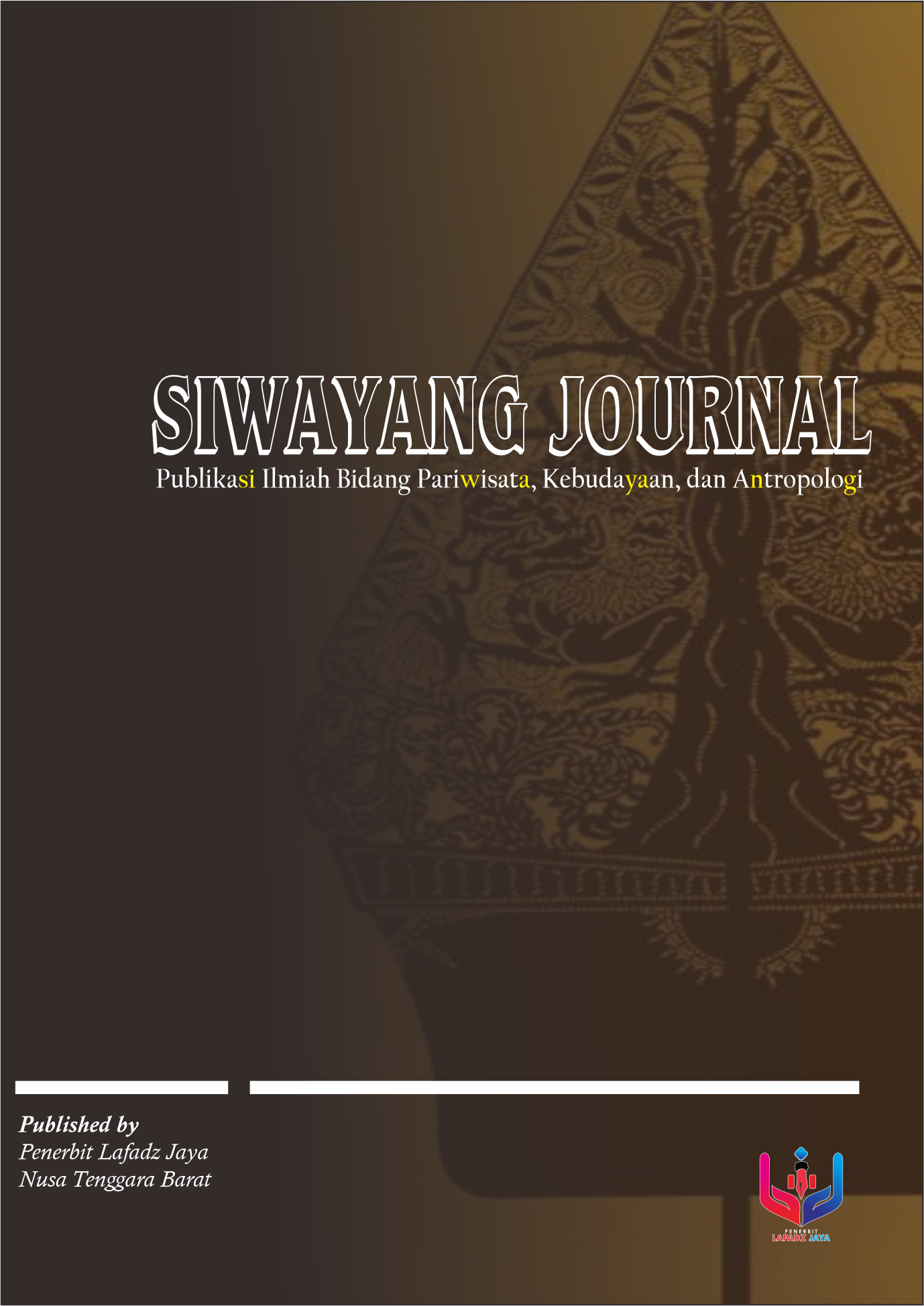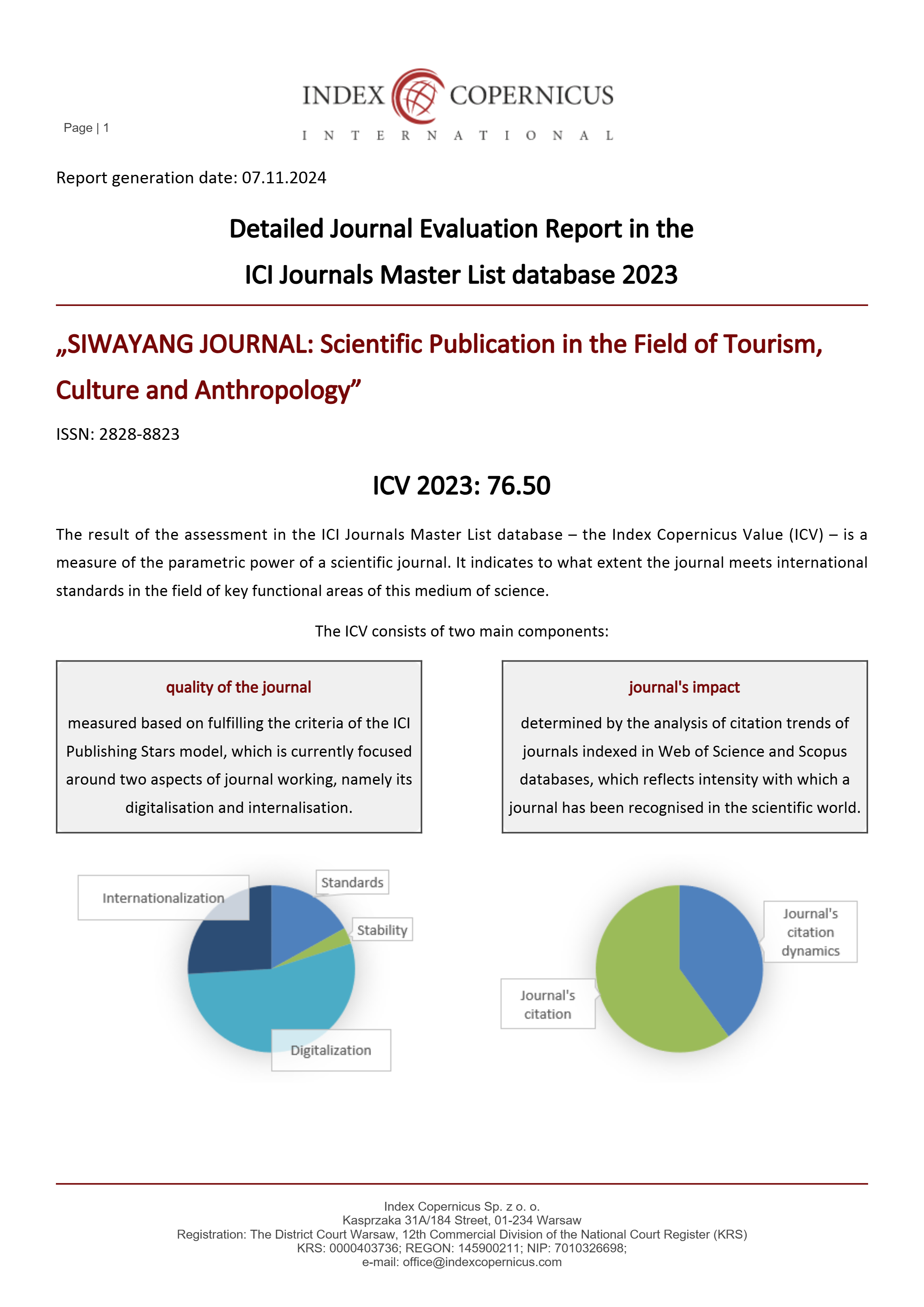ANALISIS SIMBOL DALAM TRADISI LEDEK PADA MASYARAKAT DUSUN DOPLANG KECAMATAN JUMANTONO
DOI:
https://doi.org/10.54443/siwayang.v2i4.1243Keywords:
symbol, tradition, LedekAbstract
This research analyzes the Ledek tradition as a ritual to ask for blessings and safety by the people of Dusun Doplang. One of the processions in this ritual, the community uses dancers called Ledek dancers as a symbol. The ritual is carried out once a year, on Friday Kliwon by the community, especially residents of Doplang Hamlet. By using qualitative research techniques, data were collected through documentation studies, observations, and in-depth interviews. Clifford Geertz's symbolic interpretation theory was used to examine the data. This study finds that the Ledek tradition still exists in Dusun Doplang and is still practiced by the community because it contains a number of symbolic elements and purposes that have an impact on the social structure of the Doplang hamlet community and encourage the Ledek tradition to continue. There are two symbolic reasons why the people of Dusun Doplang must continue to uphold the Ledek tradition: (1) As a symbol of friendship that strengthens togetherness, and (2) As a sign of tolerance, (3) The community needs to socialize. Then for its functions, namely as: (1) The function of safety, (2) The function of maintaining local wisdom, (3) The function of maintaining solidarity between communities.
Downloads
References
Mulyana, Deddy, Metodelogi Penilitian Kualitatif, Bandung: PT. Remaja Rosdakarya, 2010. Hlm 7.
Lexy J.Moleong, Metodelogi Penelitian Kualitatif, Bandung: PT. Remaja Rosdakarya, 2013.Samaji Sarosa, Penelitian Kualitatif: Dasar-Dasar, Jakarta: Indeks, 2012.
Saifuddin, Fedyan A. 2006. Antropologi Kontenporer: Suatu Pengantar Kritis Mengenai Paradigma, Jakarta :Kencana Prenada Media Group.
Soekanto, Soerjono. 2012. Sosiologi Suatu Pengantar. Jakarta:PT Raja GrafindoPersada.
Goodman, Douglas J & Ritzer, George. 2004. Teori Sosiologi Modern. Jakarta : PT PrenadaKencana.
Langan, Novialti Naomi. 2014. Makna pesan Tari Ma’rading Dalam Upacara Adat Rambu Solo’ di Tana Toraja, Makassar; Universitas Hasanuddin.
Sugiyono. Metode Penelitian Kuantitatif, Kualitatif, Dan R & D. Bandung: Alfabeta, 2016.
Herusatoto, Budiono. Simbolisme Jawa. Yogyakarta: Ombak, 2008
Damsar. 2011. Pengantar Sosiologi Pendidikan. Jakarta. Kencana..
Achmad, Fedyani. 2005. Antropologi Kontemporer, Suatu Pengantar Kritis Mengenai Paradigma. Jakarta. Prenada Media.
Geertz, Clifford. 2003. Tafsir Kebudayaan. (diterjemahkan oleh : Fransisco Budi Hardiman) Yogyakarta:Kanisius.
Laksmi, Desember 2017, Journal Of Library and Information Science, volume 1.
Vardinasyah, Dani.2004. Pengantar Ilmu Komunikasi. Bogor, Ghalia Indonesia.
Soyomukti, N. 2010. Pengantar Sosiologi Dasar Analisis, Teori, dan pendekatan Menuju Analisis Masalah-Masalah Sosial, Perubahan Sosial, dan Kajian-Kajian Strategis.Jogyakarta: Ar-Ruzz
Ritzer, G. 2014. Teori Sosiologi Modern Edisi 7, Jakarta: Kencana Prenada media Group.
Berlian, E. 2016. Metodologi Penelitian Kualitatif dan Kuantitatif. Padang: Sukabina Press.
Solihah, R. 2019. Agama dan Budaya; Pengaruh Keagamaan Masyarakat Gebang Madura. Al-Mada; Jurnal Agama, Sosial Dan Budaya, 2(1), 77–94.
Koentjaraningrat, 1970, Manusia dan Kebudayaan di Indonesia, Djambatan, Jakarta.
Muchtar, Prof. Rusdi. 2009. Harmonisasi Agama dan Budaya di Indonesia. Jakarta: Balai Penelitian dan Pengembangan Agama.
Sumarto. (2013). Budaya, Pemahaman dan Penerapannya “Aspek Sistem Religi, Bahasa, Pengetahuan, Sosial, Keseninan dan Teknologi.” Africa’s Potential for the Ecological Intensification of Agriculture, 53(9), 1689–1699.
Downloads
Published
How to Cite
Issue
Section
License
Copyright (c) 2023 Ema Fitriana, Siany Indria, Bagas Narendra Parahita

This work is licensed under a Creative Commons Attribution-NonCommercial 4.0 International License.











